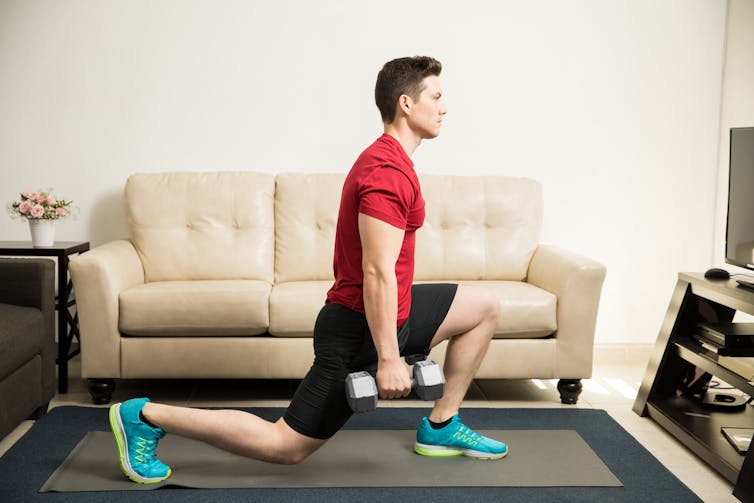Millions of people worldwide make running their exercise of choice. And whether you’ve just started running and are aiming to run a 5km or are aiming to run a marathon, you’re probably looking for ways to improve.
While most training programmes for runners focus primarily on increasing the amount of running you do, becoming a better runner isn’t only about putting in more miles. In fact, what many runners don’t realise is that it’s important to include strength training as part of your programme.
Here’s why:

antoniodiaz/ Shutterstock
1. Improves performance
A key factor in endurance running performance is running economy. This is the amount of oxygen your body consumes at different running speeds. Improving running economy can help people run farther and faster – with research showing that more economical runners are able to use their energy more effectively during their runs.
Strength training has consistently been shown to improve running economy. This is because strength training, such as heavy resistance exercise (squats or leg press) or body weight plyometrics (jumping & hopping) can improve the use of elastic energy – meaning you’re better able to propel your body forward, reducing the amount of work the muscles actually need to do.
Strength training can even help people run faster. This may be explained by the changes that happen in our muscle fibres, or because strength training changes our brain and nervous system so that our muscles are better able to apply force during movement.
This could be especially advantageous in middle-distance events – such as running events between 800m and 3,000m.
2. May reduce injury risk
One downside of running is that it comes with a relatively high risk of leg, foot and ankle injuries because of overuse. Some research suggests that around 40% of runners suffer an injury every year of training.
But strength training can help reduce the number of overuse injuries runners experience. This might be due to the positive changes in muscle, tendon and bone health that happen as a result of strength training.
Strength training can improve hip abductor strength (which help provide stability during movement) which can reduce instances of iliotibial band syndrome, a common knee injury that’s caused by the iliotibial band (which runs from your pelvic bone to your knee) rubbing against your hip and knee bones. Strength training can also help improve ankle strength, which is a known risk factor for Achilles tendon injuries.

While there is some promising early evidence that performing strength training reduces injury risk in runners more research is needed to confirm this. But general guidelines suggest that performing short duration, high-intensity strength training, such as lower body resistance exercises (including squats and lunges) can protect against overuse injuries in runners.
3. Improves the way you run
Around 80% of the energy we use when we run goes toward supporting our body weight and propelling our body forward. So if a runner can reduce the amount that their centre of mass (the balance point of the body) moves up and down (called vertical oscillation) while running, they might be more efficient.
To understand this, we need to consider Newton’s laws of motion. Gravity is accelerating our body mass towards the centre of earth and we counter this by applying an equal and opposite force against it. The longer it takes us to apply this force, the more our centre of mass will move downwards and thus the longer our foot will need to be in contact with the ground every stride we take.
If we have stronger muscles and tendons, we can reduce this motion and “spring” back more easily each time our foot makes contact with the ground. Strength training improves the strength of our muscle and tendons and the rate at which force can be applied. This is one factor that helps improve our running economy.
Some studies also show that strength training improves torso and hip biomechanics which should in theory lead to more efficient running and better running economy. As such, runners may benefit from many strength exercises such as squats, lunges and step-ups that help build strength in the torso and lower limbs.
Getting started
It’s recommended that runners do at least 2-3 strength training sessions a week for at least six to 14 weeks to start out with. Many different types of strength training are likely to be beneficial, but heavy strength training (lifting a challenging amount of weight) and plyometric training (such as jumping, hopping, skipping) have been shown to be most beneficial for performance.
Any runners that want to start strength training should work with an expert, and build up slowly while aiming to be consistent. Plyometric training should start with lower impact exercises, such as box jumps or skipping, and progress intensity gradually. For strength training, we’d recommend movements that engage the whole body – such as squatting, lunges and step-ups. We’d also recommend exercises that seek to strengthen specific muscles that are prone to overuse injuries, such as the calves and hip muscles.
Alongside improving running performance, resistance training has many other health benefits – with just 30-90 minutes a week enough to reduce risk of premature death from all causes.
Matthew Wright, Lecturer in Biomechanics and Strength and Conditioning, Teesside University and Jonathan Taylor, Lecturer in Sport and Exercise, Teesside University
This article is republished from The Conversation under a Creative Commons license. Read the original article.
